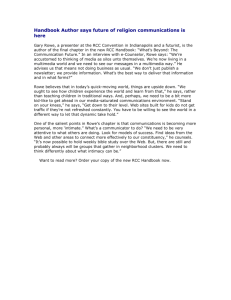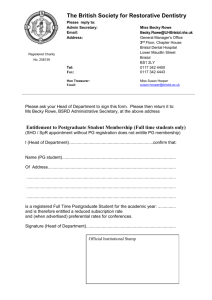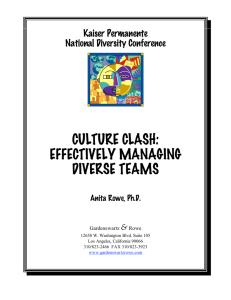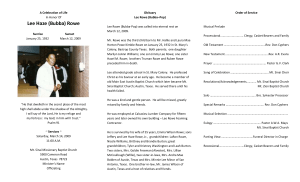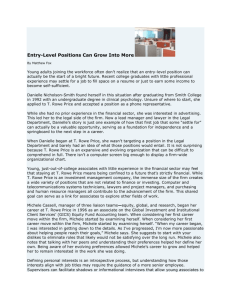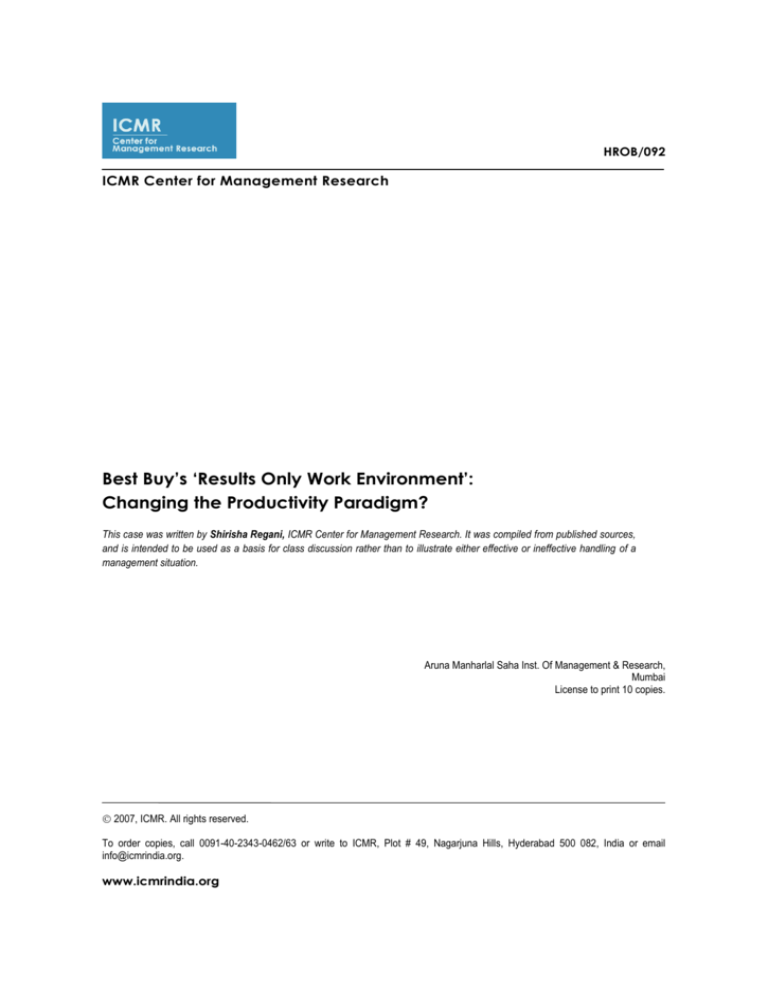
HROB/092
ICMR Center for Management Research
Best Buy’s ‘Results Only Work Environment’:
Changing the Productivity Paradigm?
This case was written by Shirisha Regani, ICMR Center for Management Research. It was compiled from published sources,
and is intended to be used as a basis for class discussion rather than to illustrate either effective or ineffective handling of a
management situation.
Aruna Manharlal Saha Inst. Of Management & Research,
Mumbai
License to print 10 copies.
2007, ICMR. All rights reserved.
To order copies, call 0091-40-2343-0462/63 or write to ICMR, Plot # 49, Nagarjuna Hills, Hyderabad 500 082, India or email
info@icmrindia.org.
www.icmrindia.org
Best Buy‟s „Results Only Work Environment‟:
Changing the Productivity Paradigm?
"ROWE was an idea born and nurtured by a handful of passionate employees. It wasn't created as
the result of some edict."
– Brad Anderson, CEO and Vice Chairman of Best Buy, in 2006. 1
“Our whole notion of paid work was developed within an assembly line culture. Showing up was
work. Best Buy is recognizing that sitting in a chair is no longer working."
– Phyllis Moen, a Professor of Sociology at the University of Minnesota, in 2006.2
“You can ridicule an obsession with face time, for example, but some companies have a strong
belief that having people at the same place, in the same time, creates synergy that is valuable to
the company. You’re going to have a hard time changing that.”
3
– Paul Rupert, a flexibility consultant at Washington DC-based Rupert & Co., in 2006.
A NEW KIND OF WORKPLACE
In 2005-2006, Best Buy Co., Inc. (Best Buy), one of the leading retailers of consumer electronic
products in the US, was in the news for implementing an innovative workplace program called
„Results Only Work Environment‟ or ROWE, for its corporate employees4. ROWE, as the name
indicated, focused only on „results‟ as a measure of employee productivity. Under ROWE,
employees were allowed to work when they wanted, where they wanted, just as long as they
achieved their targets. Hours were not measured and putting in an appearance at the office was not
necessary.
As of late 2006, the program was still finding its feet, but it was already widely discussed and
analyzed. In some corporate circles, ROWE was hailed as a path-breaking program, which would
give new meaning to flexibility and work/life balance. Skeptics however, were concerned about
the chaos that could be created if thousands of employees in every organization worked without
authorized boundaries.
ROWE differed from traditional „flexible work schedules‟ in that, under flexibility, employees
were still expected to put in an appearance at the workplace. Either the start and finish times were
flexible, or employees worked for a certain number of days in the week at home and the rest at
office. Under ROWE however, coming in to office was entirely voluntary. Even physical
attendance at meetings was not compulsory.
1
2
3
4
George Anderson, “Best Buy Realigns Work Environment for Results,” www.retailwire.com, December 7, 2006.
Michelle Conlin, “Smashing the Clock,” BusinessWeek, December 11, 2006.
Patrick J. Kiger “ROWE‟s Adaptability Questioned,” Workforce Management (accessed on December 26, 2006.)
It did not apply to retail employees as of early 2007.
1
Aruna Manharlal Saha Inst. Of Management & Research,
Mumbai
License to print 10 copies.
Best Buy’s ‘Results Only Work Environment’: ….
In the early 2000s, workplace stress had become a matter of concern in the US as well as other
developed economies in the world. In the US, the number of hours in the work-week had
reportedly increased from the earlier-typical 40 hours, to more than 60 hours (stretching to even 80
hours in some industries). Moreover, it was said that Americans worked longer hours than any
other workforce in the world.5 In this scenario, many reputed companies set up work/life balance
programs, which allowed employees to prioritize their activities. ROWE was the most radical of
these programs.
BACKGROUND
Best Buy‟s history starts in 1966, when Richard Schultz (Schultz), and his partner opened an audio
specialty store called „Sound of Music‟ in St. Paul, Minnesota. Business grew, and the partners
opened two new stores near the University of Minnesota in 1967.
In 1969, Sound of Music stock began to be traded publicly, and the company also established its
first employee stock option plan. The next year, the company breached the one million dollar 6
sales mark for the first time. Over the next decade, Sound of Music grew rapidly, and improved its
offerings by including the latest video and laser disc equipment in its product lineup (it was also
the first retailer in the US to sell video equipment).
In 1983, Sound of Music‟s board of directors approved a proposal to change the company‟s name
to Best Buy. The company‟s first superstore under the „Best Buy‟ name opened in Burnsville in
Minnesota. The superstore was much larger than most electronics stores and featured an expanded
product and service range including a wide assortment of discounted brand-name goods, central
service, and warehouse distribution. The store also started selling consumer appliances.
Best Buy was listed on the New York Stock Exchange in 1987. In the late 1980s, the company
adopted the unique „yellow tag‟ design for its logo (Refer to Exhibit I for the logo). In 1989, Best
Buy implemented a new policy where it stopped paying commissions to its sales staff, shifting
them instead to a salary. This did not go down well with both the sales staff as well as electronics
and appliance companies like Toshiba Corporation and Hitachi Ltd., which depended on sales staff
to push their premium-priced products. However, customers reportedly liked the „no-pressure‟
atmosphere at the stores which resulted from the sales staff being less pushy.
Revenues grew rapidly after this, and Best Buy embarked upon an expansion spree. In the early
1990s, it entered markets like Chicago, Philadelphia, and Boston. In 1995, Best Buy became the
biggest seller of personal computers (PCs) in the US, which placed it in a good position to take
advantage of the internet boom of the late 1990s. In 1996, Best Buy became the largest electronics
retailer in the US, overtaking Circuit City Stores Inc7.
In early 2001, Best Buy acquired Musicland Stores Corp. (Musicland), a mall-based retailer of
CDs, for $685 million8. Although Best Buy had hoped to expand its presence in the music industry
through the acquisition, the move backfired, as sales of CDs were adversely affected by the
increasing popularity of MP3s during that time. In the same year, Best Buy launched Redline
Entertainment, an independent music label and action-sports video distributor.
5
6
8
Lesley Stahl, “Working 24/7,” CBS News, July 23, 2006.
Dollars ($) refers to US dollars.
7
Circuit City was a Richmond, Virginia based electronics retailer. As of 2006, Circuit City was the third largest
electronics retailer in the US behind Best Buy and Wal-Mart Stores Inc.
“Best Buy sells Musicland unit,” New Mexico Business Weekly, June 16, 2003
2
Best Buy’s ‘Results Only Work Environment’: ….
In 2002, Brad Anderson (Anderson), who had joined Best Buy in 1973, succeeded Schultz as the
CEO. Best Buy‟s business was badly affected in the early 2000s by the economic slowdown that
followed the September 11, 2001 terrorist attacks. In addition to this, discounters like Wal-Mart
Stores Inc. (Wal-Mart) and Costco Wholesale Corporation (Costco) had started expanding the
range of their consumer electronics offerings, which resulted in increased competition for Best
Buy.
In October 2002, Best Buy acquired Geek Squad, a Minneapolis-based startup that specialized in
repairing and installing PCs. The market for digital devices and home networks was booming in
the early 2000s, and the technical services market had huge potential. Besides, it was thought that
providing installation and services would help differentiate Best Buy from companies like WalMart, which typically did not provide such services. (Over the next few years, Geek Squads were
set up at all Best Buy stores and became one of the most successful businesses for the company.)
By the early 2000s, Best Buy had opened stores in all the major markets of the US. The company
then started looking at international markets, opening its first store outside the US in Toronto,
Canada, in late 2002. In 2003, the company had 600 stores across the US. That same year, it
opened its first global sourcing office in Shanghai, China. It also moved to a new corporate
headquarters in Richfield, Minneapolis.
In the early 2000s, Best Buy‟s growth in the US had begun to plateau. In a bid to provide an
impetus to growth, Andrerson launched a new „centricity‟ initiative at the company in 2003. Under
this initiative, each of Best Buy‟s stores was to be redesigned to appeal to a specific pre-defined
customer segment like „affulent tech enthusiast‟, „suburban homemaker‟, „young gadget fiend‟,
and „price conscious family guy‟. (Some stores catered to two or more segments). In the same
year, Best Buy divested its stake in Musicland.
In 2004, Best Buy launched „Learning Place‟, a post-purchase, online customer service center,
which allowed customers to purchase secure access to interactive product user-manuals, live
text/voice chat services and a discussion forum to help them use, fix and extend the products they
had bought. In 2006, Best Buy acquired a majority interest in China‟s fourth-largest appliance and
consumer electronics retailer Jiangsu Five Star Appliance Co. Ltd. The company also announced
that it planned to open stores in Shanghai in the future.
As of late 2006, Best Buy operated over 740 Best Buy stores, 20 Magnolia Audio Video Stores,
and 12 stand-alone Geek Squads in the US. Additionally, the company operated 44 Best Buy
stores, 118 Future Shop stores, and five stand-alone Geek Squad operations in Canada. In the fiscal
year ended February 2006, Best Buy posted revenues of $30.8 billion, and a net income of $1.1
billion (Refer to Exhibit II for Best Buy’s Annual Income Statement). The company employed
around 128,000 people in 2006.
BEST BUY‟S WORK CULTURE
Over the years, Best Buy had evolved a demanding work culture that glorified long hours.
Rewards and recognition went to employees who were willing to give work priority over personal
life, and there was little scope for work/life balance. Reportedly, a Best Buy manager once gave a
recognition plaque to an employee “who turns on the lights in the morning and turns them off at
night.”9
Managers monitored their teams closely, and flexibility was unheard of. For example, one manager
reportedly asked his team to sign-out before going out for lunch, giving their destination and
contact information.10
9
10
Jyoti Thottam, “Reworking Work,” Time, July 25, 2005.
Michelle Conlin, “Smashing the Clock,” BusinessWeek, December 11, 2006.
3
Best Buy’s ‘Results Only Work Environment’: ….
It was also common for employees to stay back late at the office for days on end to complete
important projects. Darrell Owens (Owens), a Best Buy employee for 14 years, said that he once
stayed up for three days in a row to write a report that was due all of a sudden. The company gave
him a bonus and a vacation for his efforts, but he had to be admitted to hospital first.11 Employees
said they sometimes had to cancel planned vacations because of work pressure.
Best Buy justified its demanding work culture on the grounds that it operated in an industry where
margins were low and competition was high. The company had to constantly find ways to do
things faster and better than competitors, while keeping costs at a minimum. This however, was
causing employee burnout.
Things had become so serious that many employees at Best Buy‟s headquarters had started
quitting, citing high work stress as the reason. There was also an increase in the number of people
filing stress-related health claims. It was also observed that there was an increasing number of
women employees who were accepting lower pay and status just to obtain the flexibility they
needed, despite their work experience and capabilities.
THE “RESULTS ONLY” WORK ENVIRONMENT
In 2003, Cali Ressler (Ressler) and her colleague at Best Buy‟s HR department, Jody Thompson
(Thompson), got together unofficially to try and develop a new workplace program that would
stem the constantly increasing attrition at the company. They came up with the program that later
came to be known as ROWE. However, they realized that the program was too radical for it to get
approval from the top management. Therefore, they waited until the right opportunity came up to
implement it. Eventually, the program was launched clandestinely at two corporate departments
(the properties and communications divisions) where the attrition was exceptionally high.
Ressler and Thompson managed to convince the managers of these two departments (who by then
were reportedly desperate enough to do anything to control the attrition) to try a workplace
program where employees were evaluated on the results achieved and nothing else. They called
this program ROWE.
The main objective of ROWE was to lower stress and improve employee morale. Ressler and
Thompson reasoned that stress could come down if employees were allowed to achieve their
targets at their own convenience, without having to account for their hours. They felt that „work‟
need not mean being in a certain place at a certain time for a specific number of hours. They
thought productivity could improve if employees were allowed to work when and where they
wanted instead of being tied to their desks at office.
The managers of the departments where the pilot program was conducted were encouraged to try
flexible scheduling, trusting their team members to work as it suited them. „Trust‟ was the
operative word in ROWE. The managers of these departments reportedly went along with the
program because it „did not cost them anything to trust their teams‟.
The initial results for ROWE were encouraging. In the first three months, turnover in these
departments fell from 14 percent to zero, job satisfaction increased 10 percent and productivity
improved 13 percent. The results encouraged Ressler and Thompson to try extending the program
to the other departments at the headquarters.
By this time, people in other departments had started hearing about ROWE and were curious about
it. Most of the lower level employees were excited about a „no restrictions‟ work environment. But
many managers were reportedly extremely skeptical about how it would work. Therefore, the
implementation of ROWE at Best Buy‟s headquarters was a slow process.
11
Jyoti Thottam, “Reworking Work,” Time, July 25, 2005.
4
Best Buy’s ‘Results Only Work Environment’: ….
The unique thing about ROWE was that it was a grassroots program. The top management had no
idea that such a program was being initiated at the company at the time it was launched, and many
of them, including Anderson, reportedly found out about it more than a year after it was launched.
THE WORKING OF ROWE
ROWE was a system which worked on the principle that productivity was the cornerstone of work.
Working did not mean being at office. Rather, work was done when results were accomplished.
ROWE‟s vision was that productivity at work should be measured by output and not by the
number of hours spent on the work.
Employees were assigned targets of what to achieve in a certain time frame (targets could be
weekly, monthly or quarterly, depending on the nature of their work and the level in the
hierarchy). Targets were usually set jointly by the manager and the employee. The employee was
then responsible for achieving these targets. Employees could choose to pace work in a way that
was convenient to them. They could also work at whatever time of the day was convenient for
them and from wherever they wanted.
ROWE created an inclusive system, which recognized that different people had different needs.
For instance, different people were productive at different times of the day. By making all people
work during set hours, the company could be losing out on their productive best. Since ROWE
allowed people to work at whatever time they felt like working, it ensured that they put in
optimum performance. Marissa Plume, a Best Buy employee, worked better at night and said she
did her best work from her bedroom at midnight after shifting to ROWE.12
Whenever a department signed up for ROWE, the entire department did so together, so that no
employee felt left out. Teams joining up for ROWE had to first work out a system by which they
could get in touch with each other when needed. Initially some teams set up an online calendar in
which everyone entered exactly where they were at any given time. Others hung whiteboards
outside their cubicles with messages like „in office today‟ or „Out of the office this afternoon,
available by e-mail.‟13 Every department had its own rules and measures to prevent flexibility from
generating chaos. For instance, the public relations department employees used pagers to ensure
that someone was always available in an emergency. Other employees made extensive use of their
cell phones and laptops to get work done even though they were not in the office.
Teams were also required to prioritize their tasks to ensure that important tasks were not ignored.
Most teams found that their regular meetings were redundant, and that they could get by with
meetings at less frequent intervals. Teams that adopted ROWE did away completely with
impromptu meetings. If meetings were necessary, they used technology like conference calling or
dialed into the meeting from wherever they were.
Traci Tobias (Tobias), the manager of the travel reimbursements team at Best Buy admitted that
the number of meetings her team held had fallen drastically after they shifted to ROWE. Earlier
the team used to lose a lot of time in unnecessary meetings, which usually ended up in idle talk.
But after the implementation of ROWE, people simply contacted the person they needed to speak
to through e-mail or cell phone, without having to set up a formal meeting and involving several
other people in it. Tobias confirmed that conversations among team members had become more
concise and to-the-point as the number of meetings decreased.
Teams also worked out the division of the tasks among themselves. For instance, if a client needed
someone to be present in office on a particular day, the managers did not take the decision as to
who should be available, but left the decision to the team members. Managers said that after the
12
13
Lesley Stahl, “Working 24/7,” CBS News, July 23, 2006.
Jyoti Thottam, “Reworking Work,” Time, July 25, 2005.
5
Best Buy’s ‘Results Only Work Environment’: ….
implementation of ROWE they had to start planning their teams‟ tasks more carefully, as they
needed to give them clear indications of what was expected from them. They could no longer just
stop by their employees‟ desks and allot work as they were not likely to be there.
ROWE teams had no typical working day. They came and went when they wanted. Reportedly,
some employees did not come to the office for weeks at a time after they shifted to ROWE, but
their productivity did not drop.
NOT AN EASY ROAD
Implementing ROWE was not easy. In the first place, it required a complete overhaul of people‟s
attitudes towards work. Traditionally, employees were programmed to think that displaying a
commitment to work by coming in early and leaving late could ensure them success. But this was
eliminated as a criterion for judging performance under ROWE.
Several employees who were working with ROWE admitted to having misgivings about whether
they would be able to cope with the new system. Some people reportedly felt confused about what
would be expected from them at the workplace. Staying longest at the office was no longer a
guarantee of success. Denise LaMere, a Best Buy corporate strategist, was one of the employees
who found it difficult to adapt to the new environment. LaMere did not have children, and
therefore had had an advantage earlier as she could spend long hours at the office. Under ROWE
however, long hours at the office became pointless. “It made me very nervous. I had all this panic.
Everything we knew about success was suddenly changing,” she said.14
Employees could also no longer look to the top for directions and instructions, which made them
feel vulnerable. “It takes away everything that you felt was normal,” said Owens.15 In the early
stages of the program, employees reportedly felt guilty when they took time off for their families
or to pursue their hobbies, and it took them a lot of time to adapt to the new way of doing things.
Managers, on the other hand, had to be able to give up control and trust their employees to get
their work done. Many managers wondered how they would establish authority if they could no
longer control their employees‟ work time. When ROWE was launched, some managers resisted it
strongly as they felt that their authority would be undermined. Many managers felt that it was big
mistake to allow employees to work as and when they wanted. They argued that this might work
well in the case of employees who were self motivated, but when applied indiscriminately to all, it
would only lead to chaos and a drop in productivity.
Some managers also argued that in some jobs, face time between the managers and employees was
very important. For instance, many managers felt that administrative assistants need to be at their
desk to „serve‟ their bosses.16 (As of late 2006, this issue had still not been resolved.)
Another problem with ROWE was that, as of 2006, it was still restricted to a few departments at
Best Buy‟s corporate offices. Because of this, when employees were transferred from a department
which had ROWE to one that did not, they felt demoralized. On the other hand, employees who
were accustomed to regular hours of work felt disturbed when they moved to a ROWE department.
Best Buy also had to confront some barriers to change in implementing ROWE. Because
employees were accustomed to certain behaviors in the workplace, and had specific ideas about
what constituted productivity, it was not easy to bring about a change in their attitudes. People who
had flexible schedules or took time off were often criticized by their more „hardworking‟
colleagues.
14
15
16
Jyoti Thottam, “Reworking Work,” Time, July 25, 2005.
Jyoti Thottam, “Reworking Work,” Time, July 25, 2005.
Jyoti Thottam, “Reworking Work,” Time, July 25, 2005.
6
Best Buy’s ‘Results Only Work Environment’: ….
Ressler and Thompson used the term „sludge‟ to refer to the collection of attitudes and comments
at the workplace that hindered the progress of ROWE. Examples of sludge included comments like
“Wow, I wish I could come in at 10,” “Out late last night?” “Were you here this weekend?” etc.17
Such comments were meant to make people on flexible schedules feel guilty. Ressler and
Thompson understood that sludge was one of the biggest impediments to the acceptance of
ROWE. Sludge made it hard for people to take time off without feeling guilty and defensive.
Therefore, handling sludge was one the biggest tasks in a ROWE implementation. Departments
usually developed their own methods to combat sludge. For instance, some employees called
„sludge‟ out aloud whenever someone made a negative comment. Others put in a dollar in a kitty
for every sludge comment they heard. As a part of ROWE training, employees were given
suggestions on how to handle sludge without becoming defensive. For instance, when asked about
where they were or why they were not in office at a certain time, employees were taught to
respond with statements like “Was there something you needed?” and “Don‟t you have my cell?”
The expectation was that a positive and non-defensive attitude would one day eliminate sludge
from the workplace.
Some departments also resisted ROWE on the grounds that their work did not lend itself to
flexibility. The legal department at Best Buy was one of the departments that had chosen not to
adopt ROWE. The reason was that Best Buy‟s lawyers were compensated in part for how well
they served their clients, and they were worried that if they took an afternoon off, or were not in
the office when clients called, they might be labeled as unresponsive. It was also difficult to apply
ROWE for general administrative staff and retail employees.
THE OUTCOMES
As of late 2006, more than 50 percent of the employees at Best Buy‟s headquarters were on
ROWE. The company announced that ROWE had yielded positive results in the few years that it
had been in practice at the headquarters. Reportedly, ROWE teams had an average 3.2 percent
lower voluntary turnover than non-ROWE teams. Average productivity of ROWE teams had also
increased 35 percent.18 Employee engagement, which was a measure of job satisfaction and hence
an important factor in retention, was also reported to be significantly higher in ROWE teams.
Best Buy reportedly witnessed several non-quantifiable benefits as well. For instance, managers at
the company said that ROWE made their work easier. They admitted that, despite their previous
misgivings, performance was actually easier to track under ROWE than under conventional
systems. Similarly, problems were also easier to identify and correct. “You can find a performance
problem a lot faster on this program, because that‟s all you‟re looking for…,” said Chap Achen , a
departmental manager at Best Buy.19
Employees were happy with their freedom. Their stress levels were reported to have fallen
significantly as they no longer had to be answerable for their time. They also did not have to worry
when a personal emergency came up. They could simply work from wherever they were, if they
were not in a position to get to the office.
ROWE was especially appreciated by people who had families, as it gave them more time to spend
with them without feeling guilty. The work/life balance that they achieved because of ROWE far
exceeded what they could have hoped to achieve from regular flexibility programs. According to
Best Buy, ROWE was appreciated by both men and women for the work/life balance it provided.
17
18
19
Michelle Conlin, “How to Kill Meetings,” BusinessWeek Online Extra, December 11, 2006.
“Case Study,” http://culturerx.com (accessed on January 8, 2006)
“Working When and Where You Want,” www.abcnews.com, October 3 2005.
7
Best Buy’s ‘Results Only Work Environment’: ….
Tobias said that previously she used to avoid her two children, aged four and two, every morning,
because if they saw her they would ask her to stay for breakfast. But under ROWE, she no longer
had to do that, as she was free to schedule her time according to her needs. Her goals were clear
and she knew exactly what she had to complete by what time. This allowed her to make time for
her family, she said.20However, Tobias emphasized that working under ROWE did not mean that
she was giving more importance to her family than to her work. It just allowed her to balance both
aspects of her life better. “The family doesn‟t always win. But the family doesn‟t always lose
either. I don‟t feel guilty anymore,” she said.21
Ressler and Thompson said that older employees often admitted to them that they felt sad about
not being able to balance their work and lives better when they were younger. “People in the babyboom generation realize what they gave up to get ahead in the workplace, and a lot of times it‟s
their families. They realize that it doesn‟t have to be that way,” said Ressler.22 Joe Pagano, a Vice
President of merchandising at Best Buy said, “I basically worked every Saturday, and some
Sundays. It‟s one of the biggest regrets of my life.”23
For the company, one of the biggest benefits in addition to the increased productivity was the
program‟s value as a retention tool. It also helped Best Buy attract the best talent in its recruitment
programs. Starting 2007, the company was planning to use ROWE as a major selling point in its
campus recruitment program.
Third party vendors of Best Buy were also said to be happy because when they dealt with the
company‟s employees they were fully committed to the task on hand, as they did not have to worry
about the time, or need to get anywhere else in a hurry.
Best Buy was impressed with the early results from ROWE, and was so convinced about its
potential that it set up a wholly owned subsidiary called CultureRx in November 2006, to provide
ROWE-oriented consulting services to external clients. CultureRx was located at Best Buy‟s
headquarters in Minneapolis, and was managed by Ressler and Thomson. As of late 2006,
CultureRx still did not have any outside clients, but the company‟s public relations representative
Rebecca Selby said that they were in talks with some „very interesting‟ potential clients.24
ROWE‟S LIMITATIONS
Notwithstanding its acceptance among employees, ROWE had several kinks that needed to be
ironed out before the program could become a workplace standard. One of the biggest concerns
about ROWE was that the difference between the work and personal time of the employees could
become blurred. Some people felt that just because employees were not working when they should
be, they might be working at all times of the day, blurring the difference between work and leisure.
This had the potential to create more stress for them than long work hours, said some analysts.
After the adoption of ROWE, some employees were reportedly working longer hours than they did
before. Some employees admitted that they sometimes worked around 70 hours a week to
complete their tasks (The standard work week at Best Buy was 40 hours). However, they said that
they did not find it pressuring to work more hours because they spread their work over seven days
instead of five. They also admitted that although they worked more hours with no additional
monetary benefit, they were happy to do it because of the flexibility.25
20
21
22
23
24
25
Jyoti Thottam, “Reworking Work,” Time, July 25, 2005.
Jyoti Thottam, “Reworking Work,” Time, July 25, 2005.
Jyoti Thottam, “Reworking Work,” Time, July 25, 2005.
Jyoti Thottam, “Reworking Work,” Time, July 25, 2005.
Patrick J. Kiger “ROWE‟s Adaptability Questioned,” Workforce Management (accessed on December 26, 2006.)
Lesley Stahl, “Working 24/7,” CBS News, July 23, 2006.
8
Best Buy’s ‘Results Only Work Environment’: ….
On the other hand, there was also a chance that managers might start piling too much work on
employees without any raise in compensation, if they saw that employees were regularly finishing
their work faster than expected and taking more free time. The general belief would be that
employees had been under-worked to start with, for them to be able to finish their work faster than
usual under ROWE.
ROWE was also highly reliant on metrics and the quantifiability of the work. This limited its
application to only those jobs where performance could be measured in quantitative terms.
However, not all the jobs in an organization lend themselves to quantification, which would make
it difficult to bring them under ROWE. ROWE would also not work for employees who preferred
to have clear schedules, and expected direction from their managers at all times.
Analysts also said that no matter what the benefits of ROWE, the program could not provide the
synergy created by face to face communication. Besides, some situations could be handled more
easily when the people were physically present. Some problems would only become more
complicated if they had to be handled over the telephone or by email. Some analysts also said that
ROWE was in fact not as innovative as Best Buy claimed. Technology companies had been
providing a similar environment to their employees for a long time. ROWE however marked the
first time when such a program had been taken up systematically in a company.
OUTLOOK
In late 2006, Best Buy announced that it was working on a project that would allow ROWE to be
implemented in a modified form in the company‟s retail stores, which employed almost 120,000
people. The company believed that an employee-friendly work environment could provide a
solution to the problem of high attrition in the stores. (Best Buy‟s voluntary attrition in its retail
stores was around 65 percent in 2006.)26 “It‟s a well-known fact that it‟s difficult to keep people
working in retail - not just at Best Buy - because of the hours and the stress. We want to look at
deeply held beliefs in the retail environment and whether they're actually in the way of both
associates‟ and customers‟ needs,” said Thompson.
Industry experts were doubtful about the efficacy of ROWE in a retail set-up. In a retail set-up
people were required to be in a certain place at a certain time. This went against the basic premise
of ROWE. Besides, most of the employees were hourly workers, and their employment was
governed by laws, which limited the flexibility to try new practices.
Best Buy, however, maintained that a modified version of ROWE could be implemented in its
retail stores. The management felt that the environment in the stores was very stressful for
employees, which was one of the reasons for the high turnover. Besides, they felt that an
unjustified amount of importance was given to timings, which added to the stress. “If you get
written up for being five minutes late for your shift, maybe that results in you being upset about it
for the next several hours and not giving as good of service to customers as a result,” said
Thompson.27
The company sought to eliminate this by setting up an employee-friendly scheduling system and
designing rewards and consequences around it. “We need to trust that when we give our retail
employees a scenario – store opens at this time, store closes at this time – we need to trust that they
will do what‟s right,” said Thompson.28 The new program would first be implemented in a pilot
store to chart its effect on productivity, employee and customer satisfaction, and turnover, and then
be extended to the other stores. The pilot project was expected to be rolled out in late 2007.
26
27
28
Lynne LaMaster, “Unplugging the Time Clock at Best Buy,” That‟s Crispy, December 11, 2006.
Patrick J. Kiger “ROWE‟s Adaptability Questioned,” Workforce Management (accessed on December 26, 2006.)
“Working When and Where You Want,” www.abcnews.com, October 3 2005.
9
Best Buy’s ‘Results Only Work Environment’: ….
Analysts‟ perceptions on the efficacy of ROWE were mixed. Jim Donahue (Donahue), a human
resources consultant at Hewitt Associates, a human resources consultancy firm, was in favor of
ROWE. According to him, although several companies had flexible work arrangements in place
for their employees, most of them restricted flexibility to a small percentage of the workforce. He
believed that the commitment of a company of Best Buy‟s size would serve to popularize flexible
arrangements for a greater part of the workforce. “A Fortune 100 employer doing this gives it a
whole bunch of legitimacy, versus coming from a consultant or from an academic who says, „This
is a good thing,‟” said Donahue.29
Others analysts however, thought ROWE could create a lot of chaos at large corporations. Paul
Rupert (Rupert), a flexibility consultant at Washington DC-based Rupert & Co., said that Best Buy
was in a position to experiment with its systems as the average age of its workforce was relatively
low. He said that as most of the managers at Best Buy were in their 30s (the average age of the
workforce at Best Buy in 2006 was 3630), it was relatively easy for the company to implement
change. However, employees at many other corporate headquarters were in their 50s and 60s, and
it would be much more challenging to implement change at these places, he felt.
Some analysts said it was difficult to determine whether increased productivity under ROWE came
about because the company had changed to ROWE or simply because it had changed. They said
that anything that was different from „the usual grind‟ could lead to a temporary spurt in
productivity. But when it became the new standard, employees could fall back into a rut.
Despite the arguments against ROWE, Best Buy was determined to press on with it. The company
announced that all the 4,000 employees working at Best Buy‟s corporate offices would be brought
under ROWE by the end of 2007.31 Whether ROWE becomes the new workplace paradigm or
leads to chaos still remains to be seen.
29
30
31
Annie Baxter, “Best Buy‟s Newest Product – Worker Satisfaction,” http://minnesota.publicradio.org, December 11,
2006.
Michelle Conlin, “Smashing the Clock,” BusinessWeek, December 11, 2006.
Michelle Conlin, “Smashing the Clock,” BusinessWeek, December 11, 2006.
10
Best Buy’s ‘Results Only Work Environment’: ….
Exhibit I
Best Buy Logo
Source: www.wikipedia.com
Exhibit II
Annual Income Statement
(All amounts in millions of US dollars except per share data)
Feb 06
Feb 05
Feb 04
Revenue
30,848.0
27,433.0
24,547.0
Cost of Goods Sold
23,122.0
20,938.0
18,350.0
7,726.0
6,495.0
6,197.0
25.0%
23.7%
25.2%
5,626.0
4,594.0
4,508.0
456.0
459.0
385.0
Operating Income
1,644.0
1,442.0
1,304.0
Operating Margin
5.3%
5.3%
5.3%
Nonoperating Income
107.0
1.0
--
30.0
--
8.0
1,721.0
1,443.0
1,296.0
581.0
509.0
496.0
Net Income After Taxes
1,140.0
934.0
800.0
Continuing Operations
1,140.0
934.0
800.0
--
50.0
(95.0)
Total Operations
1,140.0
984.0
705.0
Total Net Income
1,140.0
984.0
705.0
Net Profit Margin
3.7%
3.6%
2.9%
Diluted EPS from Total Net Income ($)
2.27
1.96
1.43
Dividends per Share
0.31
0.28
0.07
Gross Profit
Gross Profit Margin
SG&A Expense
Depreciation & Amortization
Nonoperating Expenses
Income Before Taxes
Income Taxes
Discontinued Operations
Source: www.hoovers.com
11
Best Buy’s ‘Results Only Work Environment’: ….
References & Suggested Readings:
1. “Best Buy Sells Musicland Unit,” New Mexico Business Weekly, June 16, 2003
2. Jyoti Thottam, “Reworking Work,” Time, July 25, 2005.
3. Ariana Eunjung Cha, “Profiling for Profit: Stores Cater to Customer Types,” The
Washington Post, August 22, 2005.
4. “Working When and Where You Want,” www.abcnews.com, October 3 2005.
5. Matthew Boyle, “Best Buy‟s Transformative CEO,” Fortune, March 23, 2006.
6. Matthew Boyle, “Best Buy‟s Giant Gamble,” Fortune, March 29, 2006.
7. Lesley Stahl, “Working 24/7,” CBS News, July 23, 2006.
8. George Anderson, “Best Buy Realigns
www.retailwire.com, December 7, 2006.
Work
Environment
for
Results,”
9. “Best Buy Rethinks the Idea of the Workplace,” insidethecubicle.blogs.com, December 7,
2006
10. Michelle Conlin, “Smashing the Clock,” BusinessWeek, December 11, 2006.
11. Michelle Conlin, “Let them Go,” BusinessWeek, December 11, 2006.
12. Michelle Conlin, “Off the Leash,” BusinessWeek, December 11, 2006.
13. Michelle Conlin, “How to Kill Meetings,” BusinessWeek, December 11, 2006.
14. Lynne LaMaster, “Unplugging the Time Clock at Best Buy,” That‟s Crispy, December 11,
2006.
15. Annie Baxter, “Best Buy‟s Newest Product
http://minnesota.publicradio.org, December 11, 2006.
–
Worker
Satisfaction,”
16. Don Loper, “Best Buy‟s Results Oriented Work Environment, a Workplace Revolution
in the Making,” www.donloper.com, December 13, 2006.
17. Melanie Turek, “Working from the Woods? At Best Buy, Making the Dream a Reality,”
www.collaborationloop.com, December 18, 2006.
18. Patrick J. Kiger, “ROWE‟s Adaptability Questioned,” Workforce Management (accessed
on December 26, 2006.)
19. “Case Study,” http://culturerx.com (accessed on January 8, 2006)
20. “How Best Buy Realized That Productivity Doesn't Necessarily Mean Being in The Office At
8am,” www.techdirt.com, December 5, 2006.
21. www.wikipedia.com
22. www.hoovers.com
23. www.bestbuy.com
12

